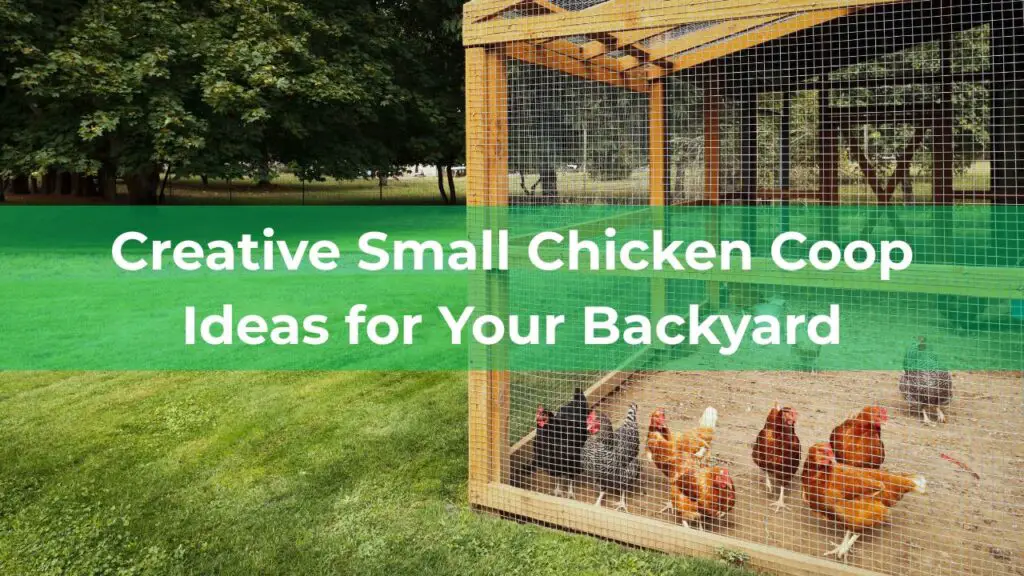Creating a small garden doesn’t have to be a challenge; it can be a fun and fulfilling project! With a little creativity and some thoughtful planning, you can turn a tiny space into a charming oasis that reflects your style and meets your needs. Let’s jump right into some practical tips and ideas to help you design your perfect little garden.
Incorporating Water Features for Tranquility
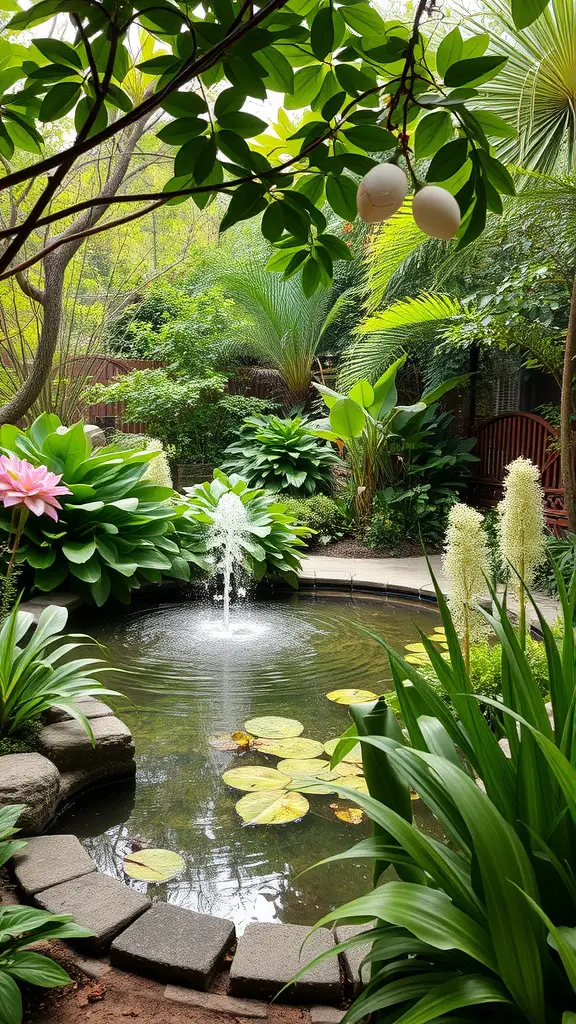
Water features can truly transform a small garden into a peaceful retreat. Imagine a gentle fountain, like the one in the image, creating a soothing sound as water dances and splashes. This kind of feature not only adds beauty but also brings a sense of calm.
The pond in the picture is surrounded by lush greenery, which enhances the tranquil vibe. The lily pads floating on the water create a serene scene, inviting you to pause and enjoy the moment. Incorporating plants around the water can also attract wildlife, like birds and butterflies, adding life to your garden.
When designing your space, think about how the water feature fits into the overall layout. It can serve as a focal point or blend seamlessly with the surrounding plants. A small garden can still have a big impact with the right water feature, making it a perfect spot for relaxation.
Layering Plants for Depth and Interest
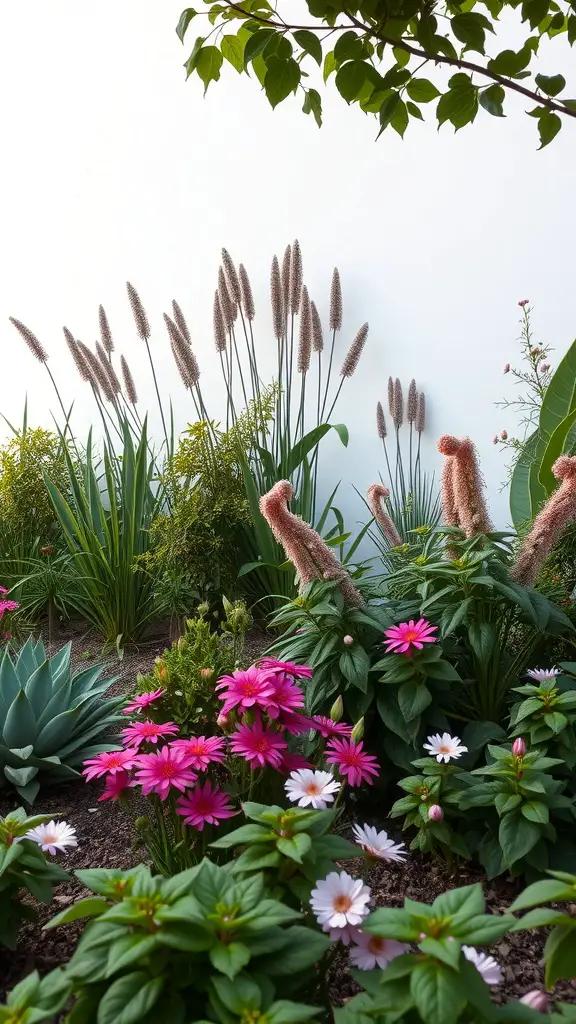
Creating a small garden can be a fun way to express your creativity. Layering plants is a great technique to add depth and visual interest. In the image, you can see a variety of plants arranged in a way that draws the eye. The taller grasses stand proudly in the back, while colorful flowers bloom in the foreground.
Using different heights helps to create a sense of dimension. The fluffy, tall grasses add texture and movement, while the vibrant pink and white flowers bring life and color. This combination not only makes the garden look fuller but also creates a beautiful contrast.
When selecting plants, consider their growth habits. Some plants spread out, while others grow upright. Mixing these types can enhance the overall look. For instance, the succulent in the lower left corner contrasts nicely with the taller plants behind it.
Don’t forget about foliage! Leaves can add their own charm and can fill in spaces between flowers. The lush green leaves in this garden complement the colorful blooms perfectly. Layering plants is all about balance and harmony, making your small garden a delightful retreat.
Designing Pathways to Maximize Space

Creating pathways in a small garden is a smart way to make the most of your space. The image shows a charming winding path made of stones, surrounded by lush greenery and colorful plants. This design invites you to explore every corner of the garden.
The gentle curves of the pathway not only guide visitors but also create the illusion of a larger area. By avoiding straight lines, the garden feels more expansive and inviting. The stones are placed thoughtfully, allowing for easy walking while blending seamlessly with the natural surroundings.
Incorporating plants along the edges adds texture and color. The low-maintenance greenery, like the soft grass and flowering plants, enhances the path without overwhelming it. This balance is key in small garden design.
Consider how the path connects different areas of your garden. It can lead to a cozy seating spot or a vibrant flower bed. Each turn can reveal something new, making the garden feel dynamic and alive. A well-designed pathway not only maximizes space but also enhances the overall experience of your garden.
Creating Vertical Gardens for Limited Spaces
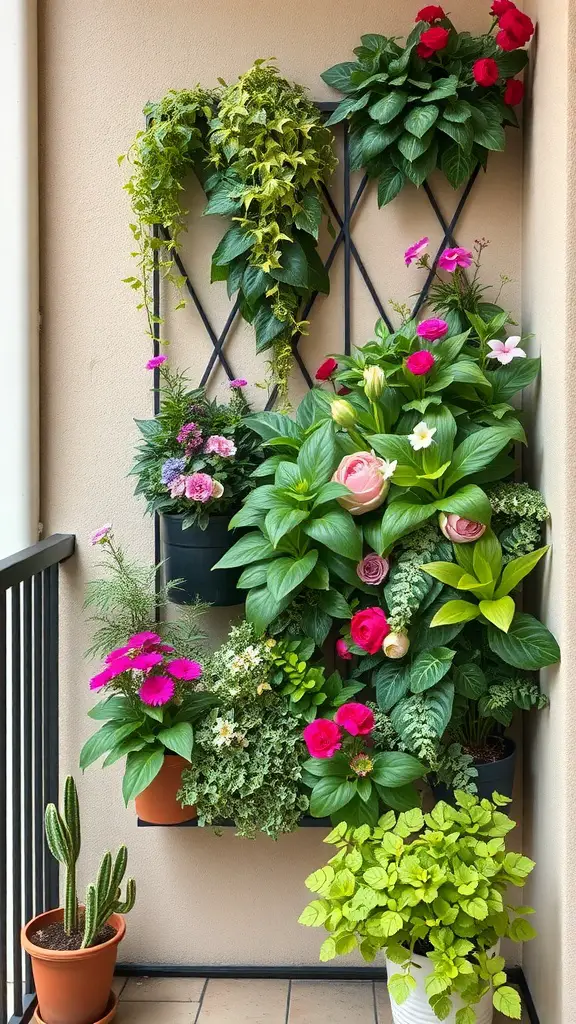
Vertical gardens are a fantastic solution for small spaces. They allow you to maximize your gardening potential without taking up much floor area. The image shows a vibrant vertical garden filled with a variety of plants, showcasing how creativity can transform a simple wall into a lush display.
This setup features an array of colorful flowers and greenery, making it visually appealing. The use of different plant types adds texture and depth, creating a lively atmosphere. You can see trailing plants, bright blooms, and even a few succulents, which are perfect for adding interest.
To create your own vertical garden, consider using wall-mounted planters or trellises. Choose plants that thrive in your local climate and can handle the sunlight available in your space. Mixing flowers with leafy greens can provide both beauty and functionality.
Don’t forget about maintenance! Regular watering and occasional pruning will keep your vertical garden looking fresh. With a little effort, you can enjoy a beautiful garden even in the smallest of areas.
Creating Focal Points with Garden Art
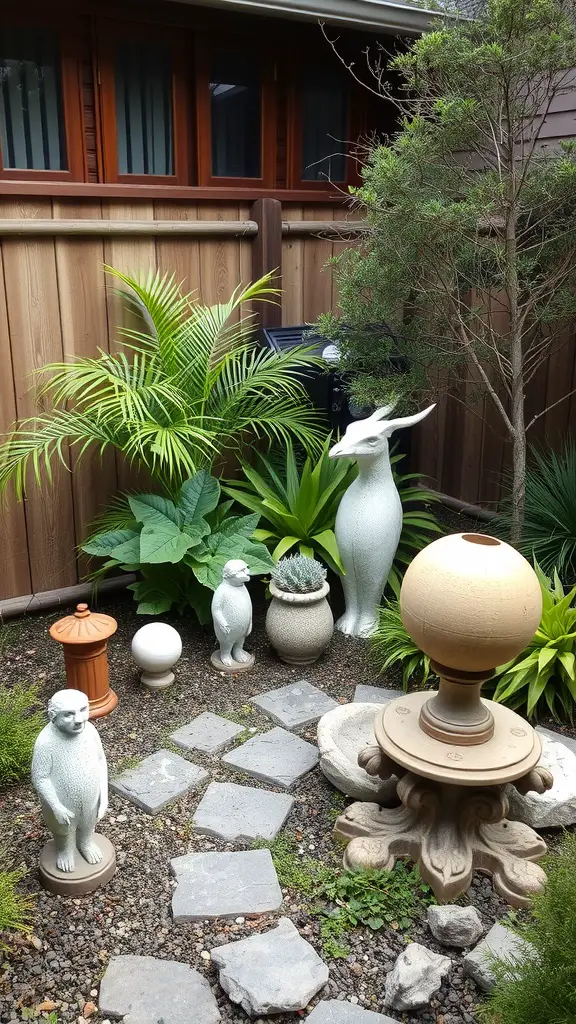
Adding garden art is a fun way to create focal points in a small garden. The image shows a cozy corner filled with unique sculptures and plants. Each piece contributes to the overall charm of the space.
The white deer statue stands tall, drawing the eye with its elegant form. Surrounding it are playful figures, like a penguin and a monkey, which add a whimsical touch. These sculptures invite curiosity and spark conversation.
Plants play a key role too. Lush greenery surrounds the art, providing a vibrant backdrop. The mix of textures and colors enhances the visual appeal. The combination of art and nature creates a balanced look.
Pathways made of stone lead through the garden, guiding visitors to each focal point. This design encourages exploration, making the garden feel welcoming and engaging. A well-placed piece can transform a simple area into a delightful retreat.
Selecting the Right Plants for Small Gardens
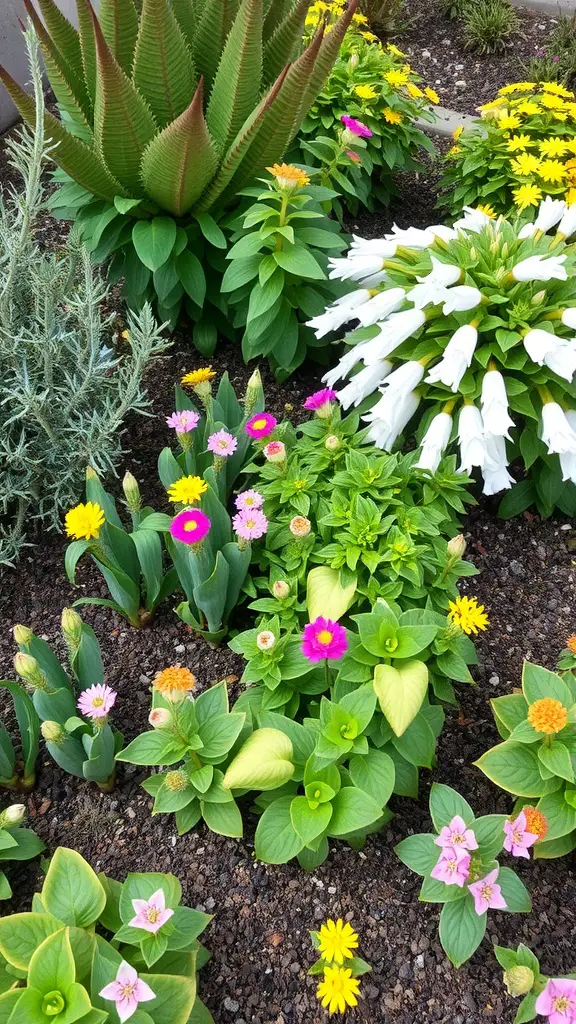
Choosing plants for a small garden can be a fun and rewarding task. The right selection can create a vibrant and inviting space, even in limited areas. In the image, you can see a colorful mix of flowers and foliage that brings life to a compact garden.
Start by considering the amount of sunlight your garden receives. Some plants thrive in full sun, while others prefer shade. The bright yellow and pink flowers in the picture suggest a sunny spot, making them ideal for cheerful blooms.
Next, think about the height and spread of the plants. Taller plants, like the spiky green ones in the back, can serve as a backdrop, while shorter flowers can fill in the front. This layering creates depth and interest.
Don’t forget about seasonal changes! Incorporating a mix of perennials and annuals ensures that your garden remains lively throughout the year. The variety of colors in the image shows how different plants can complement each other beautifully.
Lastly, consider maintenance. Some plants require more care than others. Choosing low-maintenance varieties can save you time and keep your garden looking great. With the right plants, your small garden can become a delightful retreat.
Utilizing Raised Beds for Efficient Planting
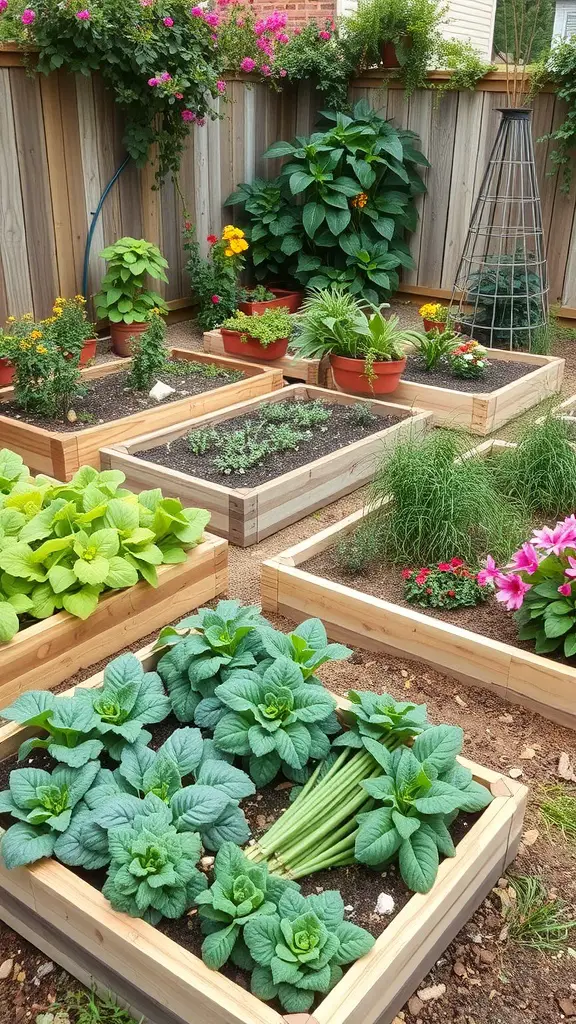
Raised beds are a fantastic way to maximize space in a small garden. They offer a neat and organized look while allowing for better soil control. The image shows several raised beds filled with vibrant plants, showcasing how effective this method can be.
One of the biggest advantages of raised beds is improved drainage. This is especially helpful in areas where water tends to pool. The plants in the image appear healthy and well-cared for, thriving in their elevated environment.
Another benefit is easier access. With raised beds, you can tend to your plants without bending over too much. This makes gardening more enjoyable and less strenuous. The variety of plants shown, from leafy greens to colorful flowers, highlights how diverse your planting options can be.
Using raised beds also allows for better pest control. The height can deter some pests and make it easier to monitor for any issues. The plants in the image look vibrant and healthy, suggesting that this method can lead to a bountiful harvest.
Finally, raised beds can be customized to fit your style. You can choose the materials and design that work best for your space. The wooden frames in the image add a rustic charm, blending beautifully with the surrounding plants. Overall, raised beds are a smart choice for anyone looking to create a productive and attractive small garden.
Incorporating Container Gardens for Flexibility
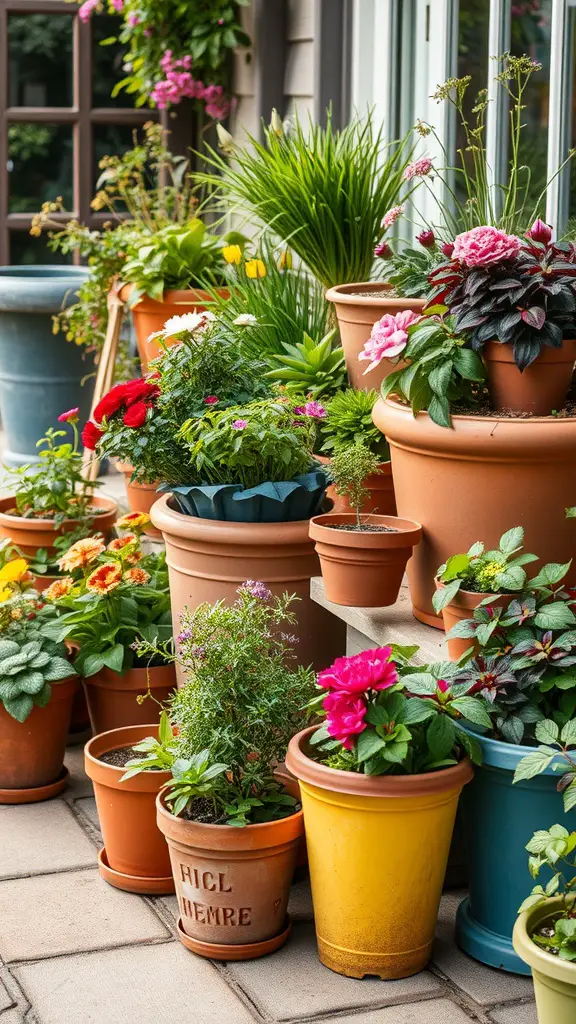
Container gardens are a fantastic way to add life to any small space. The image shows a vibrant collection of potted plants, each bringing its own splash of color and texture. From bright flowers to lush greenery, these containers create a lively atmosphere.
One of the great things about container gardening is its flexibility. You can easily rearrange pots to change the look of your garden. If you want to highlight a particular flower or create a cozy corner, just move the pots around. This adaptability makes it easy to experiment with different layouts.
Container gardens are also perfect for those who may not have a lot of ground space. You can place pots on patios, balconies, or even windowsills. This means you can enjoy gardening no matter the size of your outdoor area.
Another benefit is the ability to control soil and drainage. Each pot can be filled with the right mix for the plants you choose, ensuring they thrive. Plus, you can easily change out plants seasonally, keeping your garden fresh and exciting.
Using Color Schemes to Enhance Aesthetics
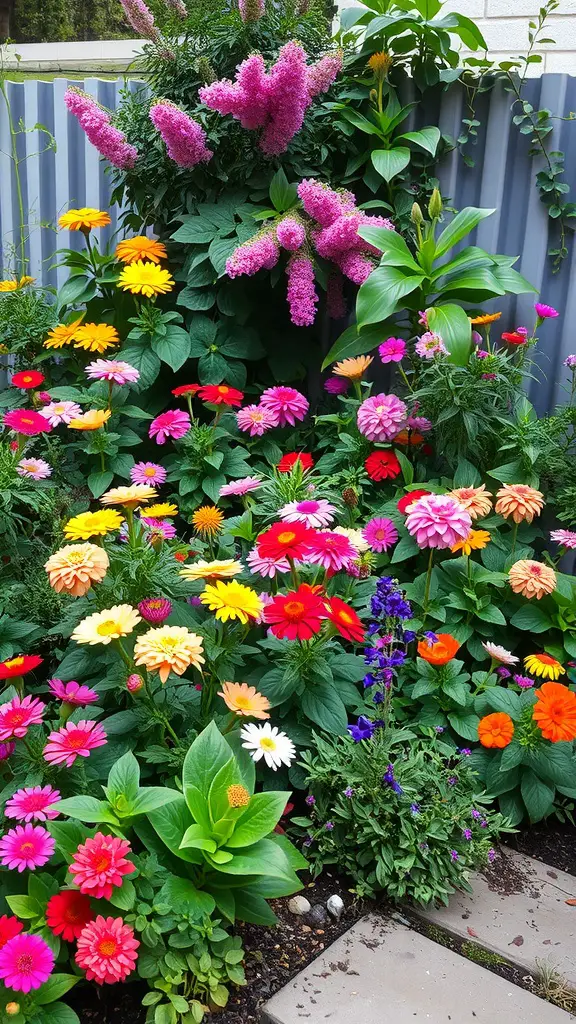
Color plays a huge role in garden design. In the image, you can see a lively mix of flowers in various shades. This vibrant palette creates a cheerful atmosphere. The bright yellows, pinks, and reds pop against the green leaves, making the garden feel inviting.
When choosing colors, think about how they work together. For instance, warm colors like red and orange can energize a space, while cool colors like blue and purple tend to calm. In this garden, the combination of warm and cool tones adds depth and interest.
Using contrasting colors can also make certain plants stand out. The deep purple flowers next to the bright yellow ones create a striking visual effect. This not only draws the eye but also highlights the beauty of each flower.
Don’t forget about the backdrop! The gray fence in the image serves as a neutral canvas, allowing the colors of the flowers to shine. A well-chosen background can enhance the overall look of your garden.
In small gardens, color schemes can make a big impact. By carefully selecting your flowers and their arrangement, you can create a stunning visual experience that brings joy to anyone who visits.
Incorporating Edible Plants into Small Gardens

Small gardens can be a delightful space to grow not just flowers, but also edible plants. The image shows a vibrant mix of colorful flowers, which can inspire you to create a garden that is both beautiful and functional.
When planning your small garden, think about adding herbs like basil, mint, or rosemary among the flowers. These plants not only enhance the visual appeal but also provide fresh ingredients for your meals.
Consider planting vegetables like cherry tomatoes or peppers, which can thrive in smaller spaces. They can be tucked in between flowers, creating a lively and productive garden.
Using vertical gardening techniques can also help maximize space. You can use trellises for climbing plants, allowing you to grow more in a limited area. This approach keeps your garden looking neat and organized.
Don’t forget about companion planting! Some flowers can attract beneficial insects, helping your edible plants thrive. Marigolds, for example, can deter pests while adding a splash of color.
With a little creativity, your small garden can be a stunning mix of beauty and bounty. Enjoy the process of growing your own food while surrounding yourself with lovely blooms!
Creating Privacy with Tall Plants and Fencing
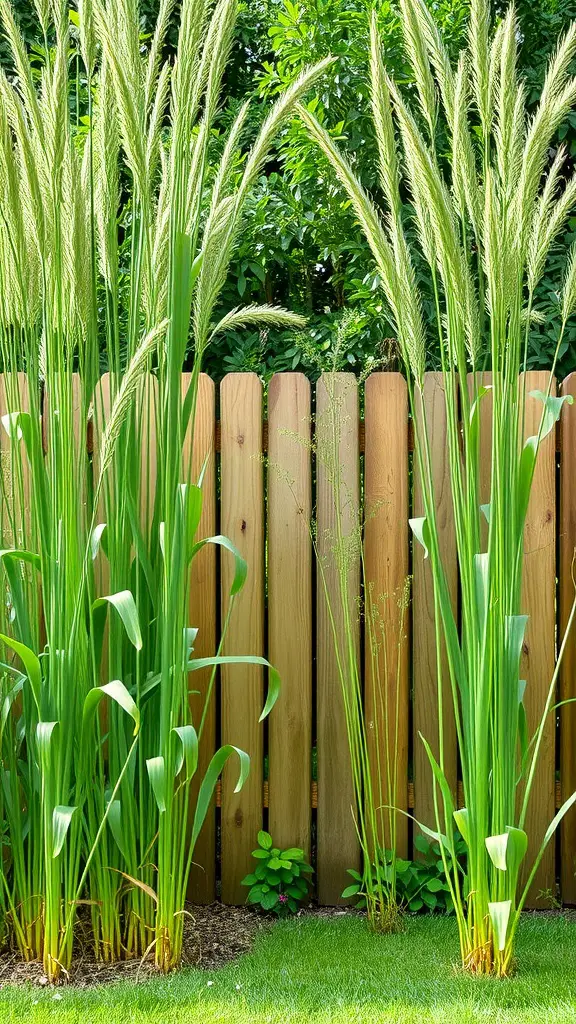
Creating a private space in your small garden can be both fun and rewarding. In the image, tall grasses stand proudly next to a wooden fence, offering a natural barrier that enhances privacy. These plants not only block the view but also add a lush, green feel to the area.
The wooden fence complements the greenery beautifully. It provides a sturdy backdrop while allowing the plants to shine. This combination is perfect for anyone looking to make their garden feel more secluded without sacrificing style.
Using tall plants like these can also help soften the look of a fence. Instead of a stark boundary, you get a gentle transition between your space and the outside world. Plus, these plants can attract birds and butterflies, bringing life to your garden.
When choosing plants, consider their height and growth habits. Opt for varieties that thrive in your climate and soil. This way, you can enjoy a vibrant and private garden for years to come.
Creating Cozy Seating Areas in Small Spaces
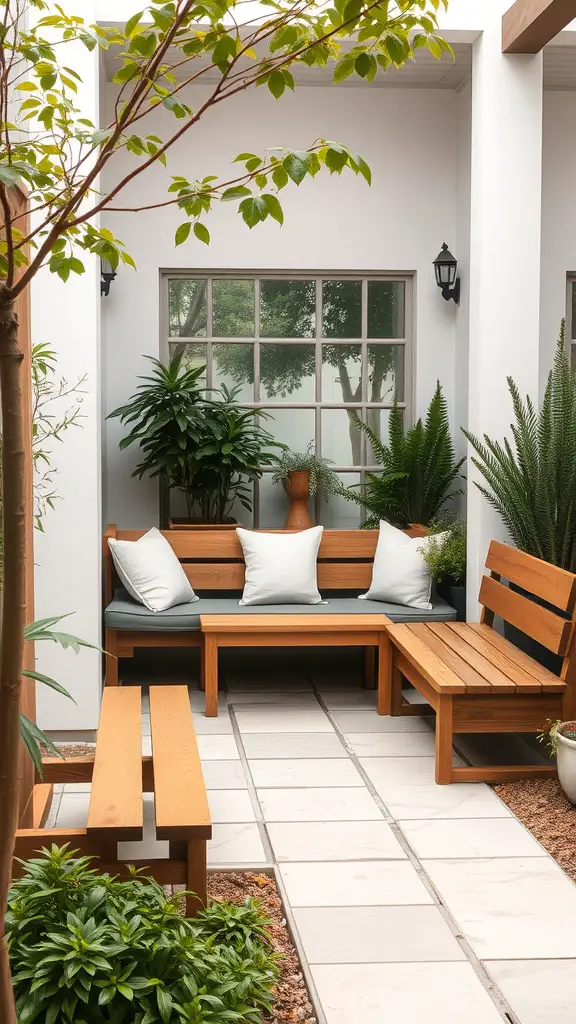
Small gardens can be a delightful retreat, especially when you create cozy seating areas. The image shows a charming seating arrangement that perfectly fits a compact space. The wooden benches and cushions invite relaxation, making it an ideal spot to unwind.
Notice how the seating is arranged to maximize comfort while keeping the area open. The use of natural materials like wood adds warmth. The greenery around enhances the feeling of being close to nature, making the space feel inviting.
In a small garden, every inch counts. This setup shows how to use available space wisely. The benches provide ample seating without overwhelming the area. Adding a few potted plants can further enhance the cozy vibe.
Lighting also plays a role in creating a welcoming atmosphere. The lanterns on the walls suggest that this space can be enjoyed even in the evening. A small garden can transform into a lovely evening hangout with the right touches.
Maximizing Sunlight with Strategic Plant Placement
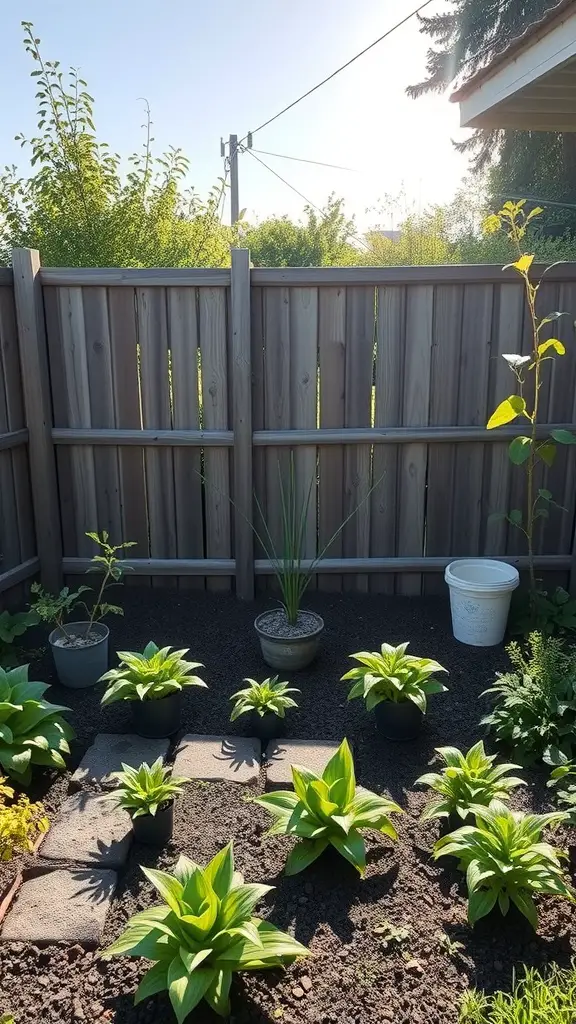
In small garden design, sunlight is key to healthy plants. The image shows a cozy garden space with various potted plants arranged thoughtfully. Notice how the plants are positioned to catch the sun’s rays. This setup helps each plant thrive.
When planning your garden, think about the sun’s path. Place taller plants where they won’t shade shorter ones. In the image, the taller plant is positioned behind the others, allowing the smaller ones to soak up the sunlight. This simple trick can make a big difference in plant health.
Using pots is another great strategy. They can be moved around to find the best light spots. The plants in the image are in black pots, which not only look nice but also help with drainage. This is important for keeping roots healthy.
Lastly, consider the type of plants you choose. Some need full sun, while others prefer partial shade. By mixing different types, you can create a vibrant garden that flourishes all season long. The arrangement in the image shows a good balance, ensuring that each plant gets what it needs.
Using Mirrors to Create Illusions of Space
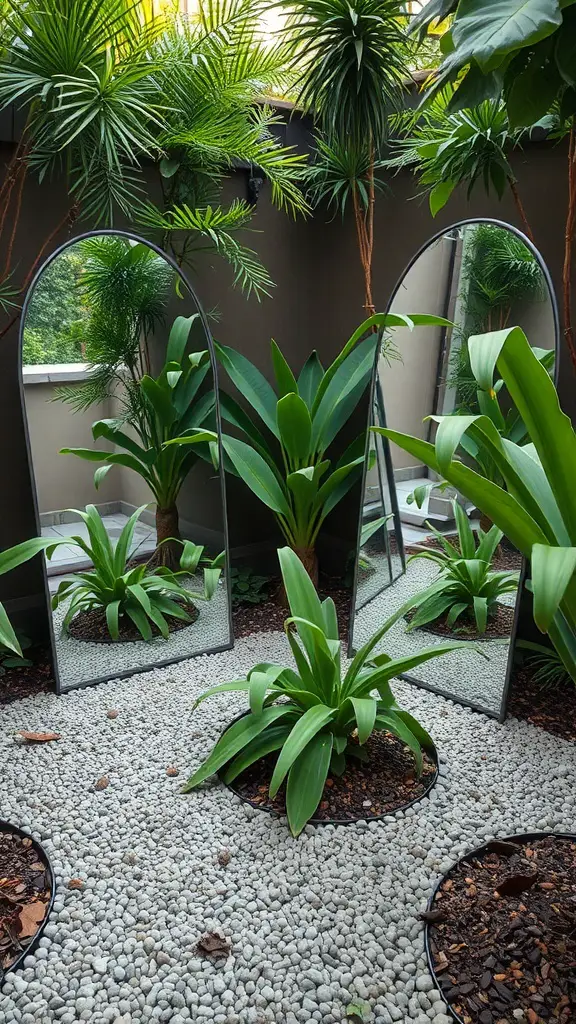
Mirrors can work wonders in small gardens. They reflect light and greenery, making the space feel larger and more open. In the image, we see a cozy garden area filled with lush plants and three tall mirrors. These mirrors create a beautiful visual effect, doubling the greenery and enhancing the overall aesthetic.
The arrangement of the mirrors is key. Positioned thoughtfully, they draw the eye and create depth. This clever use of mirrors can transform even the tiniest garden into a serene retreat. The gravel path adds a nice contrast, guiding visitors through the space while the plants bring life and color.
Using mirrors in your garden design can also highlight specific plants or features. By reflecting a favorite flower or a unique garden ornament, you can create focal points that catch the eye. This not only adds interest but also encourages exploration of the garden.
Seasonal Planting for Year-Round Interest
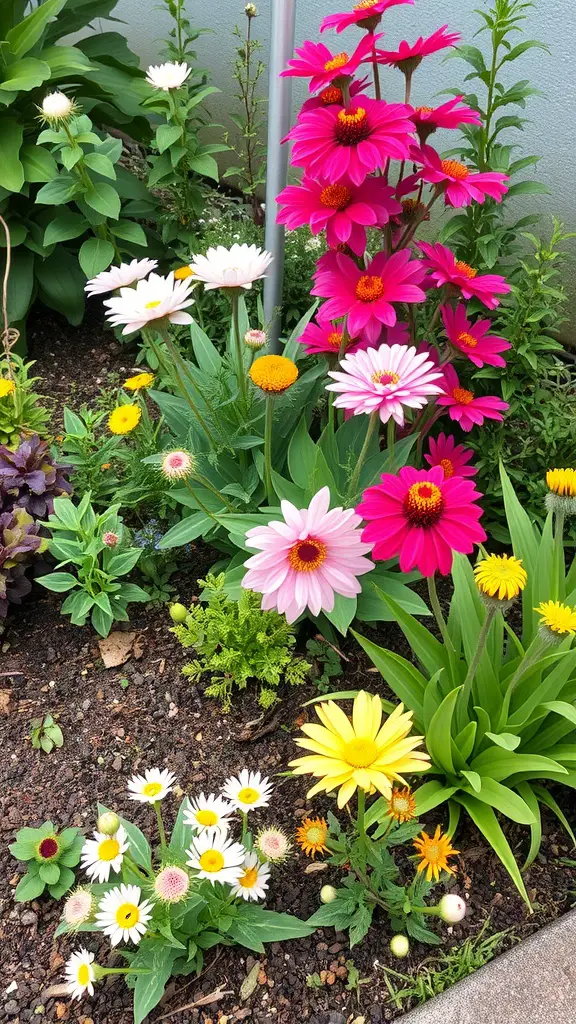
Creating a small garden can be a delightful way to enjoy nature right at home. The image showcases a vibrant mix of flowers, each bringing its own charm to the space. Bright pink and yellow blooms stand tall, surrounded by cheerful daisies and lush green foliage. This colorful arrangement highlights how seasonal planting can keep your garden lively throughout the year.
In spring, flowers like daisies and bright pink blooms can add a burst of color. As summer approaches, consider adding sunflowers or other heat-loving plants to keep the energy high. Fall can bring in warm hues with chrysanthemums, while winter can be brightened with evergreens or winter-blooming plants. This approach ensures your garden remains visually appealing no matter the season.
Mixing different types of plants not only creates a stunning visual but also supports local wildlife. Bees and butterflies are drawn to a variety of flowers, helping your garden thrive. So, whether you’re planting for beauty or for the environment, seasonal planting is a great way to keep your small garden interesting all year long.
Utilizing Garden Lighting for Evening Ambiance
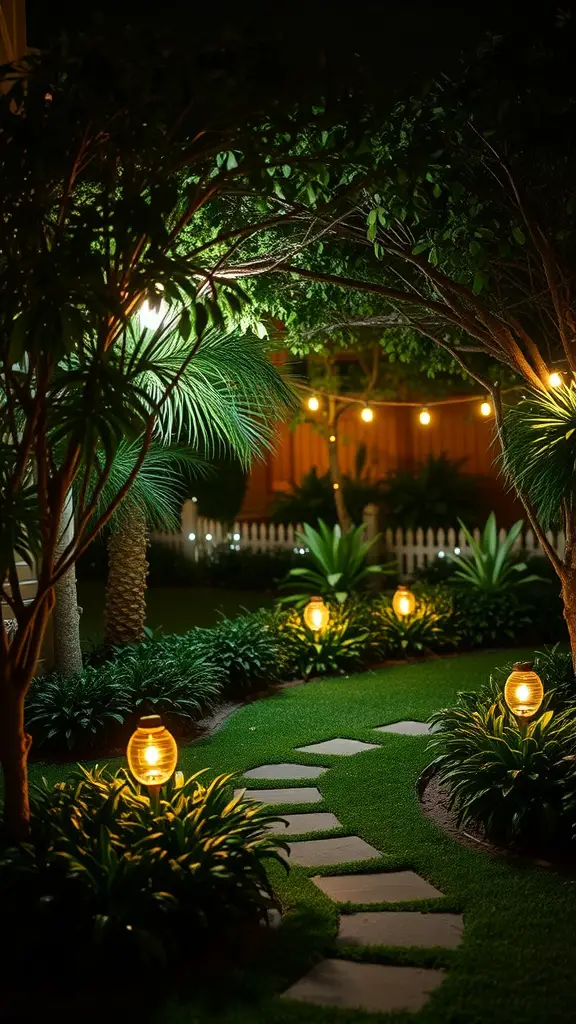
Garden lighting can truly transform your outdoor space into a magical retreat at night. The image showcases a charming garden path illuminated by soft lights, creating a warm and inviting atmosphere. The pathway, lined with lush greenery, guides the eye and encourages exploration.
Strategically placed lights not only enhance safety but also highlight the beauty of your plants and landscaping. The gentle glow from the lanterns adds a cozy touch, making it perfect for evening gatherings or quiet moments under the stars. Consider using different types of lights, such as string lights or spotlights, to create layers of light that add depth to your garden.
Incorporating lighting into your garden design can also extend the usability of your space. Whether it’s for a dinner party or a peaceful night alone, well-placed lights can make your garden feel welcoming and alive. So, don’t shy away from experimenting with various lighting options to find what best suits your style and enhances your small garden.
Adding Textures for Visual Appeal
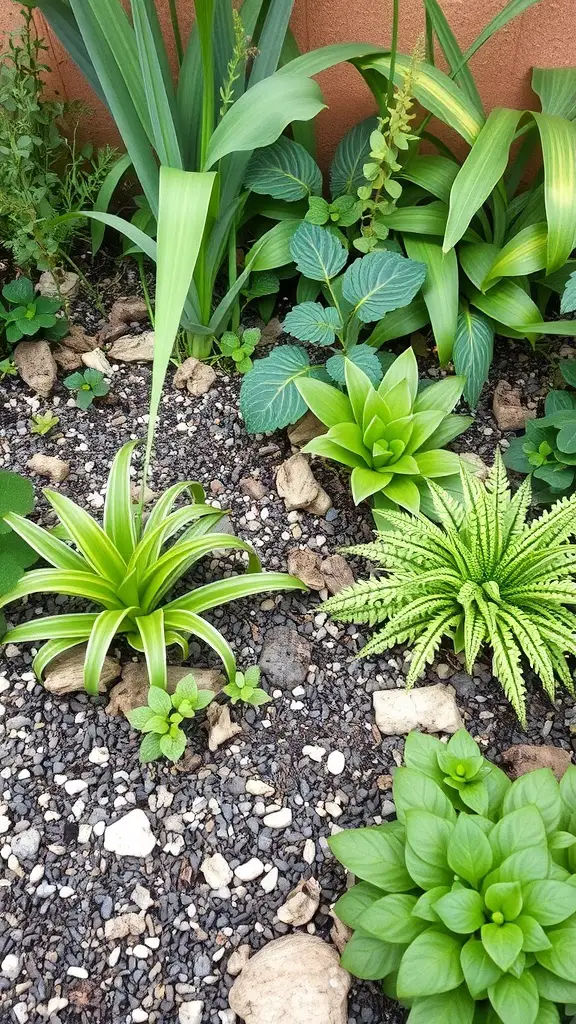
Creating a small garden can be a fun and rewarding project. One way to enhance its beauty is by adding different textures. The image shows a lovely arrangement of various plants, each with unique shapes and colors.
The tall, slender leaves of the green plants contrast nicely with the broader, rounder leaves of others. This mix creates a dynamic look that draws the eye. The use of rocks and gravel in the soil adds another layer of texture, making the garden feel more natural.
Incorporating plants with different leaf patterns, like the striped one in the center, adds interest. The vibrant greens and subtle variations in color can make even a small space feel lush and inviting. Remember, it’s all about balancing these elements to create a cohesive design.
Sustainable Practices in Small Garden Design
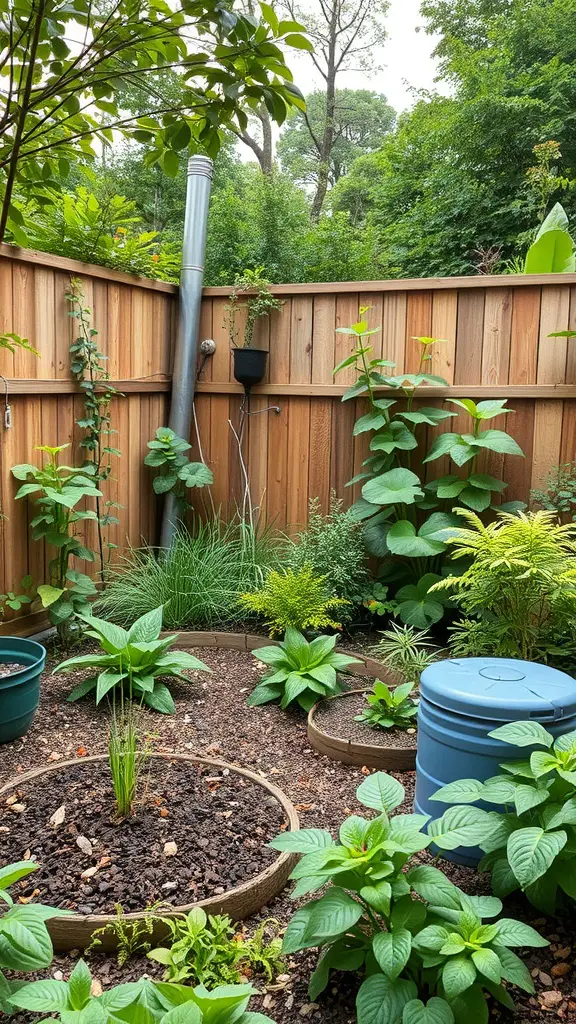
Creating a small garden can be a rewarding experience, especially when you incorporate sustainable practices. The image shows a vibrant garden space with various plants and a rainwater collection system. This setup not only enhances the garden’s beauty but also promotes eco-friendly gardening. Using native plants is a great way to attract local wildlife while requiring less water and maintenance.
Incorporating a rain barrel, like the blue one in the image, helps collect rainwater for irrigation. This reduces water waste and conserves resources. Mulching around plants, as seen in the garden, helps retain moisture and suppress weeds. Composting kitchen scraps and yard waste can also enrich the soil, making it healthier for plants.
Small gardens can thrive with careful planning and sustainable choices. By focusing on eco-friendly methods, you can create a lush, green space that benefits both you and the environment.
Creating Multi-Functional Spaces for Activities
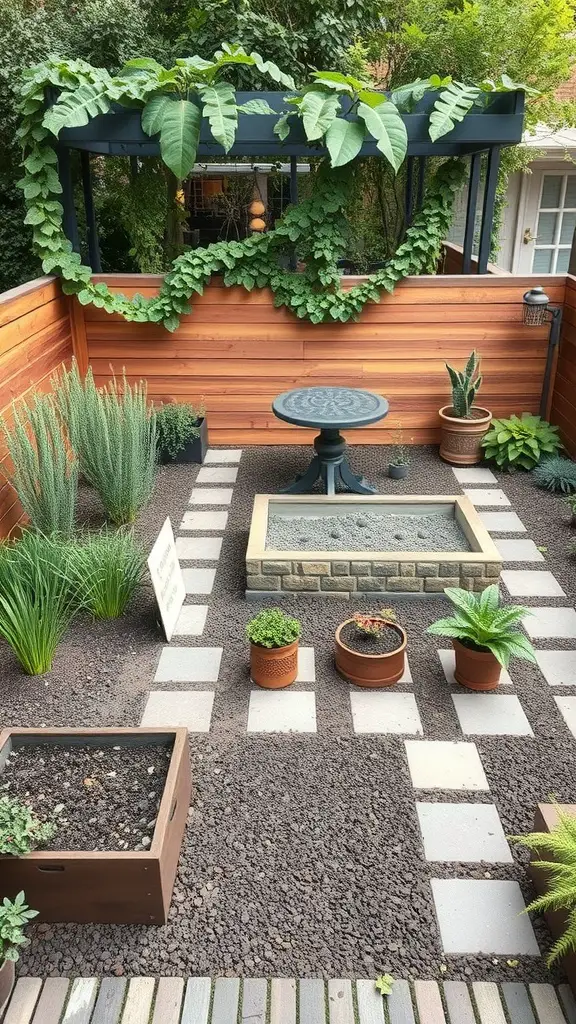
Designing a small garden can be a fun way to create a space that serves multiple purposes. This image showcases a charming garden layout that balances aesthetics with functionality.
The central feature is a lovely table, perfect for enjoying morning coffee or hosting small gatherings. Surrounding it are various plants in pots, adding color and life to the space. The use of different textures, from the smooth stones to the earthy soil, creates a visually appealing environment.
Pathways made of pavers guide visitors through the garden, making it easy to navigate. This design encourages interaction, whether it’s tending to the plants or simply relaxing in a serene setting. The greenery overhead provides shade, making the area comfortable for outdoor activities.
Incorporating seating and plant beds allows for both relaxation and gardening, making this garden a versatile spot for various activities. It’s a great example of how to maximize a small area while keeping it inviting and functional.
Personalizing Your Garden with Unique Decor
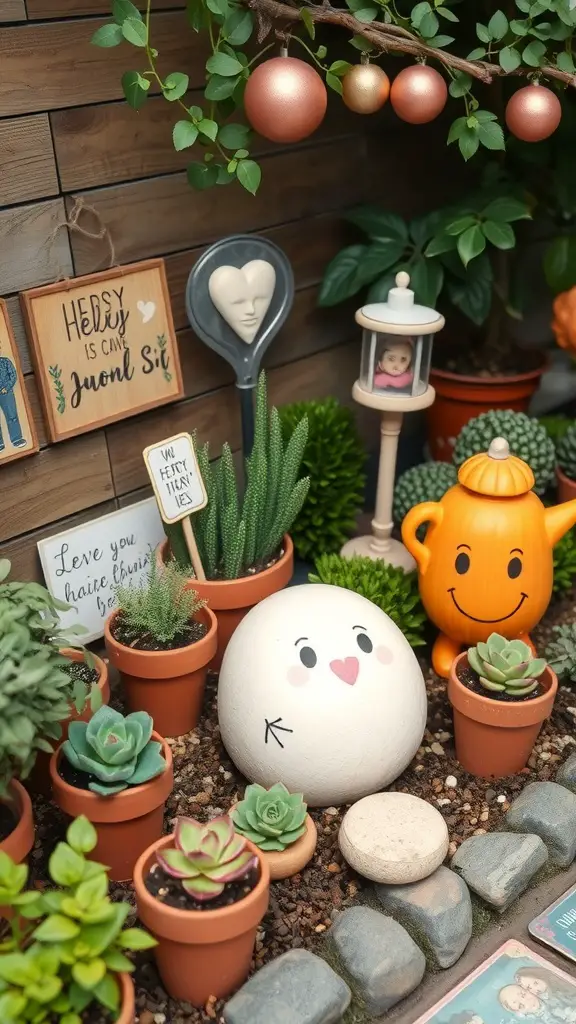
Your garden is a reflection of your personality, and adding unique decor can make it truly special. In the image, you can see a vibrant collection of potted plants, each with its own charm. The variety of succulents brings life and color, while the quirky signs add a playful touch.
Notice the thoughtful placement of items like the stone face and the whimsical hanging decorations. These elements create a cozy atmosphere, inviting you to spend time outdoors. Personal touches, like the handmade signs, can tell a story or share a message, making your garden feel more like home.
Don’t shy away from mixing different styles. Combining rustic pots with modern decor can create an interesting contrast. Whether it’s a small statue, colorful stones, or even fairy lights, these details can transform your garden into a personal sanctuary.
Incorporating Wildlife-Friendly Elements
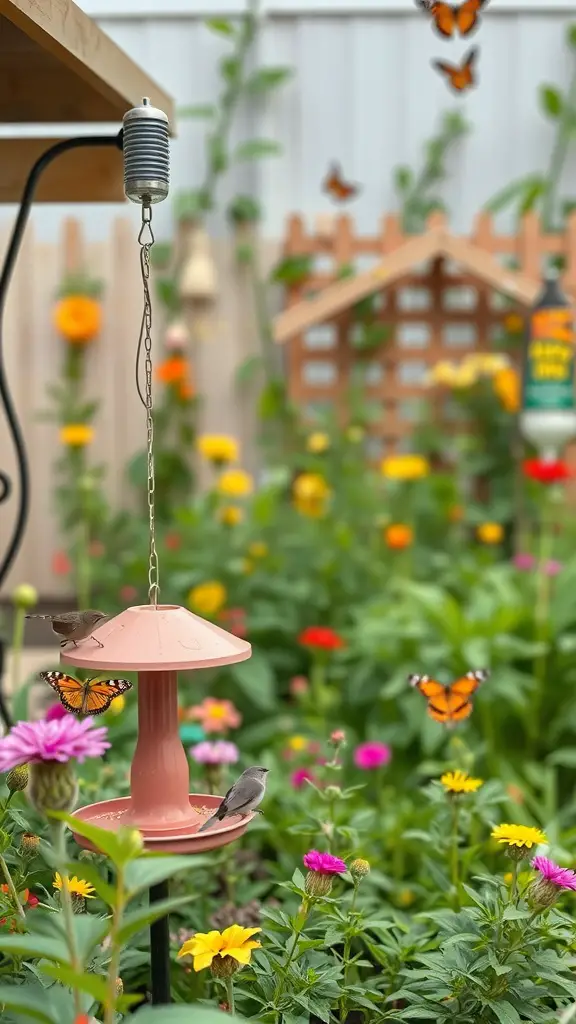
Creating a small garden can be a delightful experience, especially when you invite wildlife into the mix. The image shows a vibrant garden filled with colorful flowers and a bird feeder, which attracts various birds and butterflies. This setup not only beautifies the space but also supports local wildlife.
Adding a bird feeder is a simple yet effective way to draw in feathered friends. The feeder in the image is designed to hold water, providing a refreshing spot for birds to drink and bathe. This encourages them to visit regularly, making your garden a lively place.
Butterflies also love gardens filled with flowers. The bright blooms in the image are perfect for attracting these lovely insects. Planting native flowers can create a welcoming environment for butterflies, offering them nectar and a place to lay their eggs.
Incorporating elements like native plants, birdhouses, and even small water features can enhance your garden’s appeal to wildlife. These features create a balanced ecosystem, allowing you to enjoy nature right in your backyard.


